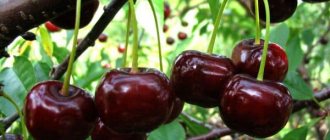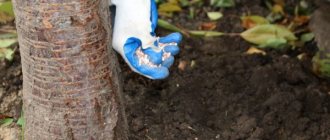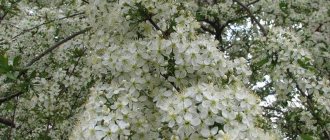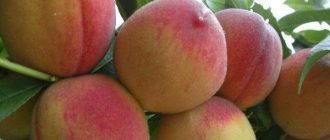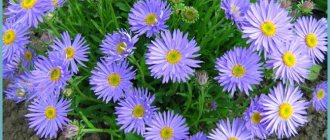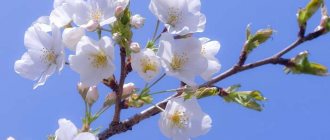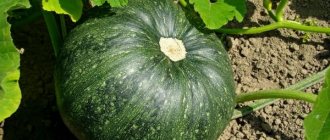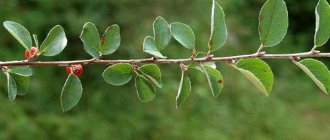Early ripening varieties for the Moscow region
The fruits of early cherry varieties ripen in early July. Early cherries differ from each other in taste, juiciness, appearance of the tree and fruit, and other characteristics.
Renaissance
The variety is characterized by high immunity - this cherry almost never gets sick. Fruits abundantly and consistently. Grows on any soil. The first fruits are produced in the 4th year of planting. The variety, due to its high immunity, is popular in many regions of Russia. Recommended pollinators – Coral, Lyubskaya, Crystal. Productivity is high - up to 25 kg per tree.
The cherries are dark burgundy with small, well-separable seeds, and excellent taste - the fruits are given 4.5 points out of 5. The berries are large, sweetish, and juicy. Weight - from 2.5 to 3.5 g. Transportable well - even in a fully ripe state. Product quality is excellent. Low maintenance requirements - water the tree only in early June and during drought.
Toy
This hybrid with large fruits is created on the basis of the Amateur cherry and the Solnechny Shar variety. Recommended pollinators are Samsonovka or Shalunya cherry, Krupnofrodnaya cherry, Valery Chkalov. The height of the hybrid is up to 7 m. The first fruits are in the 3rd year after planting. The harvest from a tree is up to 45 kg, maximum – 72 kg. Fruits up to 25 years.
The fruits are dark red, very large, weigh 7-9 g. They have red tender pulp, the taste is sweet and sour. Rating score – 4.5 out of 5. The fruits are eaten fresh, juices and wines are prepared. The stone is easily separated from the pulp. Tolerates frosts up to 25 °C. In the conditions of the Moscow region it requires insulation.
Memory of Enikeev
This self-fertile variety is considered mid-early. The tree reaches 3 m. 9-10 kg of berries are collected from the tree, maximum 15 kg. They bear fruit from 3-4 years. The fruits ripen together.
The fruits are medium-sized, weight – 5 g. The berries are oval and dark red in color. The taste is dessert, sweet and sour. Tolerates winter satisfactorily, drought resistance is average. The bones are large and oval in shape. Resistance to coccomycosis is average.
Rastorguevskaya
Early-mid ripening variety. On one tree they collect 8-10 kg of cherries. The first fruits appear in the 3rd year. The variety is self-fertile. Harvests are friendly, plentiful, stable.
The cherries are round, dark red, weighing 4 g. The taste is sweet and sour, rating - 4.4 points. The seeds are large, well separated from the pulp. Relative resistance to coccomycosis. Recovers well after freezing.
Silvia
A productive variety with an early-medium ripening period. From 1 hectare – 460-660 c. From 1 tree – 12 kg. The plant is medium-sized, up to 3 m, the crown is spreading, rounded. Self-fertility is high.
High resistance to coccomycosis. The berries are round-oval, dark red, almost black. The berries are small. Weight – 2 g. The taste is sweet and sour, the purpose is universal. Winter hardiness is high. Poor resistance to disease.
Crystal
Compactness is the main feature of this variety. It is also valued for its winter hardiness and high resistance to coccomycosis. The height of the tree is about 3 m. It is recommended to plant Lyubskaya or Coral varieties nearby. Fruiting occurs in the 4th year of planting.
The berries weigh 5-6 g. Ripening is early or mid-July, depending on the weather. The downside is low immunity to moniliosis.
Bagryannaya
Bagryannaya cherry is the best early ripening variety among other varieties of this crop recommended for cultivation in the Moscow region. Bagryana was bred by the outstanding fruit breeder Kh.K. Enikeev, who is the author of other popular cherry varieties, such as Molodezhnaya, Griot Moscow, Brunette, Silva, etc. Bagryannaya was included in the State Register in 1965, and today does not lose its relevance.
Related article:
Feeding cherries: feeding options
| Originator and year of inclusion in the register | FGBNU VSTISP, Moscow, 1965 |
| Mature plant height | Up to 2 m |
| Need for pollinators | Partial self-fertility |
| Ripening time | First half of July |
| Fruit weight | 3-4 g |
| Taste | Sweet and sour |
| Productivity | 6-7 kg per tree |
| Frost resistance | Average |
| Immunity | Can be affected by various fungal diseases, in particular coccomycosis |
Crimson is a medium-sized tree with a lush spherical crown. The leaves are medium-sized, slightly glossy, dark green in color. According to the official description, Bagryanaya is considered a partially self-fertile crop. However, for better fruiting, it is recommended to plant other cherry crops with the same flowering period in the garden. These include Shubinka and Griot Moscow.
Crimson drupes are broad-heart-shaped. The skin is dark red, elastic, smooth. The pulp is light red, very juicy. The bone is small. Cherries are used for fresh consumption, making desserts, juices, compotes, jams and other preparations.
Interesting read: Beautiful trees for the garden
Mid-season varieties
The average ripening period for cherries occurs at the very equator of summer. Their fruits, having absorbed maximum solar heat, delight gardeners with the sweetness, juiciness and tenderness of the pulp.
Volochaevka
This variety is valuable for its resistance to moniliosis. For decades, cherries in domestic orchards have been plagued by this fungal disease. Many gardeners even refuse cherries because of this scourge. Volochaevka is low - only 2-3 m. Fruits appear by 4-5 years of life. 10-15 kg of cherries grow on a tree, 20 kg in the southern regions. Harvest - July 20-25. Every year there is a stable and abundant harvest.
The fruits are dark red, the taste is dominated by sweetness and a delicate, cherry aroma. Weight – 2.7-4.5 g. Tolerates frosts down to minus 30°C. In severe frosts, the kidneys may be damaged. There is a danger of coccomycosis. The level of self-fertility is high - it can do without pollinators. Transportability is average. The fruits are tasty fresh and easy to process.
Moniliosis or fruit rot is widespread in the Moscow region, as well as throughout the temperate climate zone. The appearance of rot is provoked by cold and damp springs, characteristic of these latitudes.
Radonezh
This dessert variety produces 50-70 centners of cherries per hectare. Without pollinators, yields drop by 60-70%. Fruits in the 4th year after planting.
The fruits are dark red, high quality - elastic, tasty, with an easily separated seed. Weight – 4-5 g. Suitable for jams, juices, wines, liqueurs. Tasting score – 4.2. High immunity to coccomycosis and moniliosis. There is a risk of inflorescences freezing.
Turgenevka (Turgenevskaya)
The variety is partially self-fertile. The height of the tree is up to 3.5 m. It produces fruits in the 4th-5th year. Up to 25 kg are collected from a tree. The tree bears fruit for up to 25 years. Pollinators – Favorite, Molodezhnaya, Lyubskaya.
The berries are dark burgundy, heart-shaped. Weight – 4-5 kg. The bones are small and easily separated. The taste is sweet and sour, ideal for cooking jams, making juices, compotes.
Bulatnikovskaya
The peculiarity of this self-fertile variety is its increased resistance to negative influences. The tree is bush-like, up to 3 m high. Withstands extreme temperatures - from minus 40 ° C to + 50 ° C. One tree produces up to 15 kg of cherries.
Round dark red berries weigh about 3.5 g. Taste rating - 3.9 points. This is the main drawback of the variety - low taste characteristics.
Cinderella
This beautifully flowering variety bears fruit in the 20th of July. Does not require pollinators. The trees are winter-hardy, densely leafy, compact. One tree can ripen up to 15 kg of cherries. Tree height is 1.5-2 m.
The dark red berries weigh about 4 g. The variety tolerates cold well and does not require antifungal treatment. The dense pulp has a pleasant taste.
Nurse
Self-sterile, mid-season duke with very large fruits. Bears fruit from the age of 3. Pollinators are needed. The tree is medium-sized.
The berries are dark cherry color with sweet pulp. Weight – up to 8 g. Combines the taste of cherries and sweet cherries. Taste and aroma are considered standard.
Spartan
This self-sterile hybrid of cherries and sweet cherries was bred for Siberia, so in the Moscow region it feels excellent - it tolerates severe frosts well. Belongs to the mid-season category. The tree is medium-sized. Harvest – 10-15 kg per tree.
The fruits are round, red-cherry in color. Weight – 6-8 g. The fruits are large and sweet. This duke is unpretentious and disease resistant.
What are self-fertile and self-pollinating varieties?
In the description of cherry varieties there are the concepts self-fertile, partially self-fertile and self-sterile. In self-fertile varieties, approximately 40% of the flowers are fertilized. In partially self-fertile varieties this figure is not higher than 20%. Self-sterile cherry varieties in the absence of pollinators can produce no more than 5% of the ovary of the total number of flowers.
For fertilization, the flower needs stamen pollen to land on the stigma. Mechanically, pollen transfer can be carried out by insects, wind, with human participation, or without intermediaries in self-pollinating plants. In this case, pollination occurs within one flower or plant.
When self-pollinating, plants are at a disadvantage because virtually no genetic information changes. The main qualities for survival - variability and adaptability - are obtained through cross-pollination due to various combinations of parental genes. To protect plants from degeneration during evolution, special protection mechanisms have been developed. As a rule, in flowers the stamen filament is shorter and the stigma is located significantly higher than the anthers. In addition, pollen, even if it gets on the pistil, is not able to germinate on its own plant and cannot fertilize the ovary. Hence the definition of “self-sterile.”
Self-sterile varieties need the proximity of other varieties of cherries and even sweet cherries. At the same time, other trees of the same variety will also not be pollinators.
Self-fertile cherries differ in the structure of the flower: the anthers of the stamens are at the level of the stigma of the pistil or slightly rise above it.
The anthers of the stamens of self-fertile cherry varieties rise slightly above the stigma of the pistil
The advantage of self-fertile varieties is that you can limit yourself to one tree within the garden plot. Some independence from weather conditions and pollinating insects, as well as the small size of the trees, distinguish these varieties. Gardeners and experts note that with pollinating trees growing nearby, the yield of self-fertile varieties increases significantly. And it’s also worth paying attention to the taste. As a rule, self-fertile cherries have a pronounced sourness, and sometimes they can be consumed only after processing.
Late Moscow region cherries
Cherry is a summer berry. All varieties of cherries, including late-ripening ones, ripen in the summer. The ripening period for late varieties is early August.
Apukhtinskaya
Apukhta cherry is well known to gardeners in central Russia. This is an ancient variety, the history of which is completely unknown. Presumably, the variety comes from the village of Apukhtino (Tula region), and is a product of folk selection. The variety is late, the fruits ripen in the second ten days of August. Flowering is later than other cherries, so Apukhtinskaya is not used as a pollinator for self-sterile varieties. The height of the tree is small - up to 3 m; it resembles a shrub in appearance.
The cherries are dark red, glossy, with a classic sour taste. Weight – 5 g. Slightly tart, with a pronounced cherry aroma. They are medium in size, with rounded, heart-shaped drupes. Many people believe that the fruits of the Apukhta cherry are not tasty enough, they are too sour. The taste of these cherries is greatly influenced by growing conditions - climate, lighting, soil quality, etc. Fruiting occurs 2-3 years after planting. After reaching 5 years, the tree produces 10-15 kg of cherries. The variety is winter-hardy and rarely gets sick. Suitable for any processing. Cons: it spoils during transportation and leaks juice.
Robin
It has the status of a technical grade - the fruits are used to make jam, preserves, and other processed products. The height of the tree is 3-4 m. The disadvantage of the Robin is that it is self-sterile. Suitable pollinators are Shubinka, Lyubskaya, Vladimirskaya. The beginning of fruiting is the 3rd-5th year. The yield of this technical variety is 10-15 tons per 1 ha, per tree - 15-16 kg.
The cherries are dark red, weighing 3-4 g. The seeds are quite large, but are easily separated from the pulp. The taste is sweet and sour. The formation of berries occurs only on one-year-old branches. Withstands frosts down to minus 25 °C. At extremely low temperatures, the buds freeze. Weak immunity against moniliosis, stronger against coccomycosis.
Coral
A distinctive feature of the variety is the scarlet or coral color of the fruits. Thanks to late flowering, the buds do not freeze during spring frosts. The yields are high and stable - up to 70 kg per tree. Tree height - up to 3 m. Suitable pollinators - Gnomik, Alatyrskaya.
The cherries are medium-sized, weighing 4.5-5.5 g. The scarlet fruits have a typical cherry taste. Plus, birds don’t like the taste of the berries. Winter hardiness is high, but transportability is very low. It is precisely because of the impossibility of transportation that this variety is not grown for sale. The variety is resistant to coccomycosis.
Rules for caring for cherries
To grow a crop, you must strictly follow the recommendations of experienced gardeners. Compliance with standard agrotechnical requirements allows you to obtain the declared yield from any plant, including cherries.
Watering
The amount of moisture consumed by one tree depends on the variety and age of the plant. The smaller the tree, the more often it needs to be watered. Mature cherries are watered rarely, but abundantly. It is advisable to avoid waterlogging and waterlogging of the soil, as well as drying out.
Feeding
Even during planting, it is recommended to apply complex mineral fertilizers and organic matter. In the future, as the tree grows, its appearance is observed; a lack of any substance will be signaled by external changes.
An adult plant is fed with organic matter once every 2-3 years, and mineral fertilizers are applied 2-3 times per season. Feeding requires attention in autumn and spring.
Trimming
The formation of the crown depends on the characteristics of the variety. Some trees are pruned in the first year. And some require formation only after a few years.
Don't forget about sanitary pruning. The sooner a deformed or diseased branch is cut down, the less harm it will cause to the tree.
Preparing the tree for winter
The climatic features of the Moscow region provide additional shelter for fruit trees in the garden. In the fall, feed with complex fertilizers, cut off unnecessary branches, and form a crown.
With the onset of cold weather, the tree is wrapped up so that the fruit buds do not freeze out during the winter cold.
short
This category of varieties is easy to maintain and harvest. Compact, small trees reach a height of 1.5-2.5 m, no more.
Youth
This variety has increased frost resistance. It does not need pollinators, and its height does not exceed 2.5 m. The tree lives only 15-20 years. It looks like a bush. Fruit buds are only on one-year-old branches. An adult tree produces up to 12 kg of cherries, from 1 hectare - 8-10 tons.
The cherries are medium-sized, dark burgundy, weigh 4.5 g. They tolerate transportation well. The seeds are small and easy to separate. The fruits are universal - they are used for food and processing. The variety is resistant to drought, but its immunity to moniliosis and coccomycosis is low - this is the main drawback of the Molodezhnaya variety.
Lyubskaya
This low, bush-like and self-fertile cherry ripens in early August. Belongs to the category of technical varieties. The compact tree grows up to 2-3 m in height. An ancient variety, folk selection. The second name is Lyubka. It produces fruits in the 3rd year after planting. 10-12 kg of cherries are harvested from a tree, the maximum yield is after 10 years, it reaches 55 kg.
The fruits are transported well. Disadvantages: low frost resistance, low immunity to fungal infections and sour taste. The tree is very decorative and is often used for landscaping. The fruits are dark red, with a thin and durable skin, weight - 4-5 g. Taste - sweet and sour. An excellent raw material for jams, jams, wines, etc. The seed has a sharp tip. The bushes almost do not form shoots. It is considered an ideal variety for technical purposes. Disadvantage: low resistance to fungal infections.
Chocolate girl
A low tree with a reverse pyramidal crown reaches 2-2.5 m in height. The first fruits are harvested in the 4-5th year. Collection from a tree – 11-12 kg. From 1 hectare – 80-90 c. With intensive care - up to 200 c/ha. Self-fertility is variable and depends on growing conditions.
The berries are flat-round, weighing 3-3.5 g. When ripe, they acquire a dark red, almost black color. The fruits are shiny, very juicy, with small, easily separated seeds. The tasting score is low - 3.8-4. The purpose is universal - eaten fresh, dried, frozen, prepared liqueurs, made jam. Winter hardiness and drought resistance are high. Disadvantage: fungal infections.
Fairy
Self-fertile variety with early and early-mid ripening. A low-growing tree up to 2.5 m high. The crown is lush and spherical. In the presence of pollinators, productivity increases by 50%. It is recommended to plant Turgenevka or Vladimirskaya nearby. Harvest per tree – 12 kg. From 1 hectare – 80-85 c. Fruits from the 3rd year.
The color of the fruit is pink, the pulp is pink-yellow. Fruit weight – 3-3.5 g. Dessert taste. Tasting score – 4.3. Tolerates frosts down to minus 38 °C. High resistance to fungal infections. Almost does not form root shoots.
Mtsenskaya
Mid-season variety for technical purposes. A tree with a spreading crown, up to 2 m high. It bears fruit in the 4th year. Productivity – 50-80 centners per 1 ha. Self-fertile.
Dark red round cherries weigh about 4 g. Tasting score - 3.8. High resistance to cracking. Average resistance to fungal diseases. Winter-hardy and drought-resistant.
Morozovka
A low-growing, self-sterile variety with medium ripening periods. The berries ripen in July - the exact timing depends on the weather. The height of the tree is up to 2.5 m. The plant has a wide, spherical crown. It produces fruits in the 3rd year of planting. Productivity – up to 60 centners per hectare.
The fruits are large, round, dark red, almost burgundy. Weight – 5 g. Resistant to frost and drought. High immunity to coccomycosis. The best pollinators are Turgenevka, Vladimirskaya, Griot Michurinsky. The downside is the low winter hardiness of flower buds.
Brunette
Tree height is 2-2.5 m. The crown is spreading, spherical. Mid-season, highly productive variety. From 1 hectare - 8-10 tons, from a tree - 10-12 kg.
The weight of the berries is 3.5-3.8 g. The color is dark burgundy, to black. Universal fruits with tender, juicy pulp. The seeds are easily separated from the pulp. Average level of resistance to fungi. The downside is the low winter hardiness of flower buds.
Assol
An unpretentious mid-season variety. Tree height is up to 2 m. Self-fertility is high - no pollinators are required. Fruiting begins at 3 years of age. Up to 70 centners are collected from 1 hectare.
The berries are red, glossy, weighing 3-4 g. The taste combines sweetness and acidity. Suitable for any workpiece. High resistance to scab and other diseases. Winter hardiness at minus 30 °C.
Tamaris
Dwarf variety. The height of the plant is no more than 2.5 m. The tree has a spreading crown and a decorative appearance. The first berries appear in the 2-3rd year of fruiting. Up to 80 centners of fruits are collected from 1 hectare, and one tree produces up to 10 kg or more - the variety is very responsive to care. The variety belongs to the mid-late variety. The berries ripen at the end of July or at the beginning of August. Self-fertility is high, but to increase productivity, pollinators are recommended - Lyubskaya, Turgenevka, Zhukovskaya.
The berries are glossy, dark red, weigh 4-5 g. The fruit has a good cherry taste, but there is more sweetness than acidity. The tree lives up to 20 years. Greater resistance to coccomycosis; the variety is less resistant to moniliosis. During transportation, the fruits may be damaged and release juice.
Bystrinka
Low-growing variety with early ripening. Maximum height – 2.5 m. Tree with a spherical crown. Berries appear in the 4th year. Up to 100 centners are collected from 1 hectare.
The berries are oval, dark red, weight - 4 g. They have juicy, aromatic pulp, its taste was rated 4.3 points. The downside is the tendency to fungal diseases. The variety is used as an amateur and industrial crop. Frost resistance is average.
Lighthouse
Bushy variety. The plant grows up to 2 m. The foliage is low. Fruiting - in the 3rd year. Harvest starts at the end of July. Up to 15 kg of cherries are collected from a tree. There are harvests of up to 25 kg. The variety is long-lived - trees bear fruit for up to 30 years. Self-fertility is partial.
The fruits are dark red, round, weight – 4-6 g. Tasting score – 4.5 points. Disadvantages - the fruits crack, transportability is low. Frost resistance – up to minus 35 °C. May be affected by fruit rot and coccomycosis.
Winter Garnet
This dwarf cherry was developed quite recently. Refers to self-pollinating varieties. Height – up to 1.8 m. The bush is compact and bears fruit abundantly. The first berries appear in the 3rd year. The harvest from a tree is up to 10 kg.
The taste of the berries is excellent, sweet and sour. Weight - 3-4 g. The variety tolerates frost well - suitable for northern regions. Frost resistance down to minus 45 °C. The tree has a decorative appearance and is disease resistant.
In memory of Mashkin
A low-growing cherry with a spherical crown, no more than 2.5 m high. It bears fruit in the 3rd year after planting. Self-fertility is partial. Berry picking – 40-65 centners per hectare.
The berries are red, heart-shaped and round. Weight – up to 5 g. Tasting score – 4.6. The taste is dessert. The variety is relatively resistant to fungal diseases. Frost resistance of the tree and buds is average.
Saratov Baby
A low-growing, mid-season hybrid obtained by mixing cherries with sweet cherries. Often the variety is simply called Malyshka. Maximum height - 2.5 m. First harvest - in the 3rd year. The crown is arched. The average yield is 15 kg per tree.
Cherries are dark red, very attractive in appearance, sweet and sour. Weight – 4-5 g. The variety is resistant to frost. The tree is very decorative. Small seeds are easily separated from the pulp. High resistance to fungi.
Shpanka Dwarf
This is one of the varieties of the Shpanka variety - a hybrid of cherries and sweet cherries. Shpanka is an ancient hybrid of folk selection. The height of the dwarf version of Shpanka is up to 3 m. Non-dwarf varieties of Shpanka reach 4-6 m. The variety needs pollinators.
The fruits are large – 5 g. The variety is tenacious and hardy, resistant to frost and fungus. Frost resistance – up to minus 35 °C.
Griot Moscow
Self-sterile variety, ripening in the 20th of July. Pollinators – Pink bottle or Vladimirskaya. The height of the tree with a spherical crown is up to 2.5 m. Up to 8 tons of berries are collected from 1 hectare. From a tree – up to 9 kg.
The berries are tasty, dark red. Weight – 3.5 g. Resistance to fungal diseases is average.
Duke is a hybrid berry crop obtained by crossing cherries and sweet cherries. It was first bred in the 17th century and received the name May Duck. Now all sweet cherries are called dukes.
Octave
The tree is low-growing, the crown is compact and rounded. It is decorative. Self-fertile, mid-season variety. Harvests from 1 hectare – up to 100 c.
The berries are dark cherry, almost black. Weight – 4 g. Shape – round-flat. The taste is good, the berries are sweet and juicy. The bones are small and can be easily removed. Average frost resistance. High bud resistance to frost. Immunity to fungal infections is average.
Bystrinka
Among the best yielding cherries for the Moscow region, the Bystrinka variety can be distinguished. The “parents” of the culture are the Zhukovskaya and Zolushka cherries, from which Bystrinka inherited a compact structure, as well as excellent taste and attractive appearance of the fruit.
The taste of Bystrinka is rated 4.3 out of 5 by professional tasters.
| Originator and year of inclusion in the register | Federal State Budgetary Institution "All-Russian Research Institute of Fruit Crop Breeding", Oryol region, 2004. |
| Mature plant height | 2-2.5 m |
| Need for pollinators | Partial self-fertility |
| Ripening time | First half of July |
| Fruit weight | 3.5 g |
| Taste | Sweet and sour |
| Productivity | 85 c/ha |
| Frost resistance | High |
| Immunity | Good |
Bystrinka has a raised, spherical, not too thick crown. The leaves are standard in shape, dark green, matte. Flowering begins around May 15th. The flowers are white, collected in inflorescences of 3-4 pieces. Fruiting occurs 4 years after the tree is transplanted into the ground.
Bystrinka has increased winter hardiness of flower buds.
The drupes are oval shaped, with a small funnel and a rounded tip. The color of the skin is dark red. The pulp is tender, melting, very juicy, with a high sugar content (9.8%). Thanks to its excellent productivity, ease of care, and high quality harvest, Bystrinka can be successfully grown both in private farms and in industrial gardens.
Related article:
How to plant cherries correctly in spring and autumn
Features of growing cherries in the Moscow region
Once upon a time, the gardens near Moscow were full of cherries, but today this fruit tree is extremely difficult to grow due to fungal diseases. When choosing a variety for the Moscow region, they take into account, first of all, immunity to disease and frost resistance. Cherry varieties for the Moscow region must be resistant to return frosts.
Factors influencing the choice of cherry varieties for cultivation in the Moscow region:
- Climate. In the Moscow region, frosts reach minus 35 °C.
- Diseases of fruit trees in the region. Moniliosis and coccomycosis are the most widespread.
- Self-fertility. In cool and damp summers, bees stop working, so it is profitable to plant self-fertile varieties in the Moscow region that do not require third-party pollination.
- Productivity and fruit characteristics. The variety you like should correspond to the climate of the Moscow region.
- Terms of ripening. In the Central regions, varieties of all ripening periods are grown - early, middle and late. When choosing, it is more important to consider the flowering period rather than the ripening period. Preferable varieties are those that bloom after the threat of return frosts - mid-season and late.
- Tree height. Gardeners especially appreciate low-growing varieties - they are convenient and decorative .
The most common fruit diseases
The damp climate of the Moscow region contributes to the spread of such dangerous fungal diseases of cherries as coccomycosis, clasterosporiosis and moniliosis.
Coccomycosis
Coccomycosis
When coccomycosis occurs, the leaves become covered with brown spots, and depressed brown spots appear on the fruits. Such fruits are tasteless and often dry out. With severe development of the disease, the leaves turn yellow and fall off early, which leads to weakening of the tree and freezing in winter.
Clusterosporiasis
Clusterosporiasis
Clusterosporiosis or holey leaf spot. Affects all parts of the plant. Small brown spots appear on the leaves, which grow and holes form in their place. Cracks appear on the branches and resin leaks out of them. The fruits stop growing and dry out.
Moniliosis (or monilial burn)
Monilial burn
The first signs of the disease appear immediately after flowering. Affected flowers darken and dry out. The disease then spreads to the leaves and shoots. They also turn brown and dry out. The wood takes on a burnt appearance. The fruits rot. Branches affected by the disease dry out.
Compliance with correct agricultural practices, mandatory spring treatment of the garden against diseases, removal of diseased and dried branches and fruits, as well as the correct choice of cherry varieties for planting will help to overcome these dangerous diseases and annually obtain good harvests in the gardens of the Moscow region.
Varieties by criteria
Cherry varieties are classified not only by ripening time. Table 1 shows the varieties of especially sweet cherries for the Moscow region, their yield and fruit weight.
Table 1
| Variety | Productivity, kg per tree | Fruit weight, g |
| Bulatnikovskaya | 15 | 3,5 |
| Volochaevka | 20 | 2,7-4,5 |
| Winter Garnet | 10 | 3-4 |
| Lighthouse | 15 | 4-6 |
| Morozovka | 15 | 5 |
| Octave | 16 | 4 |
| Memory of Enikeev | 15 | 5 |
| Saratov Baby | 15 | 4-5 |
| Spartan | 10-15 | 6-8 |
| Tamaris | 10 | 4-5 |
| Fairy | 12 | 3-3,5 |
| Chocolate girl | 11-12 | 3-3,5 |
We also recommend reading the article about the best varieties of cherries.
Cherry varieties for the Moscow region, classified into various categories - in table 2
| Self-fertile varieties | Large-fruited varieties | Varieties that are particularly resistant to disease | The most winter-hardy varieties |
| Apukhtinkaya | Fairy | Fairy | Fairy |
| Bulatnikovskaya | Shpanka Dwarf | Bulatnikovskaya | Bulatnikovskaya |
| Lyubskaya | Tamaris | Radonezh | Lyubskaya |
| Volochaevka | Spartan | Silvia | Robin |
| Youth | Saratov Baby | Turgenevka | Turgenevka |
| Radonezh | Morozovka | Morozovka | Youth |
| Chocolate girl | Nurse | Volochaevka | Chocolate girl |
Table 4 shows the most delicious varieties of cherries for the Moscow region.
Table 4
| Variety | Berry weight, g | Taste | Tasting score | Sugar content, % |
| Memory of Enikeev | 4,5-5 | sweet, slightly acidic | 4,8 | 10 |
| Assol | 3-4 | sweet and sour, with sourness | 4,7 | 10 |
| Volochaevka | 2,7-4,5 | sweet and sour | 4,7 | 10 |
| Chocolate girl | 3-3,5 | sweet and sour | 4,6 | 12 |
Despite the difficulty of growing cherries in the middle climate, local gardeners can obtain decent yields. When choosing a variety for the Moscow region, in addition to the yield, size and taste of the fruit, it is important to take into account its winter hardiness, pollination methods, tree height and disease resistance.
0
0
Copy link
Zhukovskaya
Zhukovskaya is rightly considered one of the sweetest varieties for the Moscow region, since the taste of the drupes is more reminiscent of cherries. The culture was obtained from Michurinsky varieties by outstanding breeders S.V. Zhukov and E.N. Kharitonova more than 70 years ago, and zoned for the Volga, Central and Central Black Earth regions.
| Originator and year of inclusion in the register | All-Russian Research Institute of Genetics and Selection of Fruit Plants named after. I.V. Michurina, Tambov region, 1947 |
| Mature plant height | 1.5-3 m |
| Need for pollinators | Yes (Vladimirskaya, Molodezhnaya, Apukhtinskaya) |
| Ripening time | After July 15 |
| Fruit weight | 4-6.5 g |
| Taste | Sweet, with pleasant sourness |
| Productivity | 15-30 kg per tree depending on its age |
| Frost resistance | Above average |
| Immunity | Resistance to coccomycosis and ring spot |
The tree is medium-sized. It has a wide-round, spreading crown of medium density. The flowers are large and white. Fruiting occurs 3 years after planting. The drupes are large, dark red, heart-shaped. The pulp is dense, juicy, and has excellent taste. Contains 15.8% dry matter, 9.3% sugars and 1.3% acids. The crop is suitable for harvesting using mechanized equipment.
Related article:
If the cherry does not bear fruit and is capricious
Features of planting and care
It is better to plant a cherry shrub orchard on a gentle slope, where there is no risk of spring stagnation of melt water. Choose an open sunny place with sufficient area for the growth of shoots. Planting and caring for bush cherries is not very difficult, but contains several important points.
Important! On a nearby plot, it is advisable to plant other varieties of cherries (pollinators) with similar flowering periods, this will increase the yield by 2-3 times
Soil preparation
Steppe cherry is less demanding on soil than tree cherry, but responds well to the application of organic and mineral fertilizers during planting.
The root system of the shrub lies close to the surface, so it is enough to prepare a fertile layer of 30-40 cm. To do this, humus (10-12 kg/m2) and complex mineral fertilizing (150 g/m2) of superphosphate are added under deep digging. Sowing green manure followed by digging during the budding phase will help improve the soil structure and fill it with organic matter.
Advice. It is better to dig holes for seedlings in advance, at least a month before planting.
Landing
It is important to start planting seedlings in the fall, three to four weeks before the first frost, or in the spring, before the start of sap flow:
- Within 3-4 days, the pit is filled with fertile soil with the addition of organic and mineral components (humus 4-5 kg, potassium salt 50 g, superphosphate 150 g, ammonium sulfate 50 g).
- Healthy young bushes with developed fibrous roots have their root collars a couple of centimeters above ground level.
- The soil around the seedlings is compacted with feet. After watering, the soil settles, and the neck should be at ground level.
One of the reasons for the increased frost resistance of steppe cherries is the ability to retain snow between the bushes and shoots. It makes sense to place the seedlings close to each other (1.5-2 x 2 m). The planting is mulched with a thick layer of dry grass or peat.
Fertilizer
If the soil is properly prepared, additional fertilizing is not necessary in the first year. For the next 2-3 years, one spring nitrogen fertilizing (urea 20 g/m2) for digging is enough. Next, the bushes enter the fruiting period and require a more serious application of nutrients: in the fall - humus for digging (8-10 kg/m2), in the spring - superphosphate 50 g/m2, potassium chloride 10-20 g/m2, urea 25 g, s subsequent sealing.
Watering
Although bush cherries are considered not very demanding in terms of soil moisture, they respond gratefully to timely watering with increased yield and juiciness of drupes. Watering 2-3 times per season is considered sufficient: after flowering, during fruit filling, at the end of summer. After each watering, shallow loosening is recommended 2-3 days later.
Trimming
Shrub cherries are characterized by independent formation of a rounded crown. Therefore, pruning is mainly aimed at reducing density and rejuvenation. Fruiting usually occurs on last year's growth, so only the excess branches growing inside the crown are removed.
Rejuvenation of cherry bushes is carried out after growth has subsided, cutting off skeletal branches at the points where branching ceases.
Since the steppe “resident” is characterized by a large number of shoots, thinning should be carried out in a timely manner. The lifespan of one bush without a decrease in fruiting is about 8-10 years. To rejuvenate the planting, strong and healthy cuttings are left, gradually replacing the old ones.
Chocolate girl
Another variety of cherries that can be called one of the most delicious for the Moscow region. The drupes grow a rich dark burgundy color, are juicy and aromatic. They are very sweet, with bright sourness and barely noticeable bitterness. The fruits are consumed fresh and are also suitable for processing: making juices, jams, drying and freezing.
| Originator and year of inclusion in the register | Federal State Budgetary Institution "All-Russian Scientific Research Institute for Breeding of Fruit Crops", Oryol region, 1996. |
| Mature plant height | 2-2.5 m |
| Need for pollinators | Partial self-fertility |
| Ripening time | First half of July |
| Fruit weight | 3-4 g |
| Taste | Sweet and sour |
| Productivity | 80 c/ha |
| Frost resistance | good |
| Immunity | Increased resistance to coccomycosis |
Chocolate plant is a low plant with a compact, raised crown. It begins to bear fruit at 4-5 years. The culture is self-fertile and does not require pollinators. The flowering period begins in the second half of May. The drupes ripen in the mid-early period, are easily separated from the stalk and have an excellent presentation. Chocolate plant is characterized by high winter hardiness, drought resistance and stable yield.
The best varieties of cherries for the middle zone
The culture is famous for its wide variety of varieties. But not every variety of it can be cultivated in this strip of Russia. Special varieties have been bred for this region that tolerate climatic conditions well. All cultivated varieties of this latitude are divided into 3 groups according to the growing season.
Early ripening varieties. The collection of their fruits begins in the second half of June. They are juicy and aromatic and taste good. The best early varieties of cherries for this region are: “Iput”, “Zheltaya Priusadnaya”, “Ovstuzhenka”, “Orlovskaya”, “Krasnaya Gorka”, “Raditsa”.
"Let's go." Medium-sized cherry, with a wide pyramidal crown. Flowering begins in mid-May. The berries are dark red, easily separated from the stalk, and large. The pulp is dense, tastes juicy and sweet. A high-yielding variety of cherries, you can collect up to 35 kg of berries from one tree. Among the advantages of the variety, its resistance to frost, fungal diseases and pests also stands out. It begins to bear fruit only after 5 years. If there is an excess of humidity, the fruits begin to crack and their taste deteriorates.
"Ovstuzhenka." The tree is low, with a dense spherical crown. The cherry blossom period occurs at the beginning of May. The variety is distinguished by large and very tasty berries, but you can only enjoy them after 5 years. They are rounded, dark red (closer to black). The pulp is juicy, but not dense, fibrous. The stone is small and can be separated from the pulp without difficulty. Sweet cherries have high frost resistance, stable yields and are not susceptible to pests and diseases.
(variety “Ovstuzhenka”)
Mid-season varieties. Fruit ripening begins in mid-summer. The best mid-season varieties are considered to be “Revna mid-season”, “Adelina”, “Beauty”, “Fatezh”, “Leningradskaya Rozovaya”, “Pobeda”.
"Adeline." A medium-sized tree up to 3-4 m high, with a spreading pyramidal crown. The first berries appear in mid-July and are heart-shaped. They are large (each weighs up to 6g), dark red with flesh of the same color. It is not dense, with red juice. The stone is small and easily separated from the pulp. This variety has good winter hardiness. The first fruiting begins after 4 years. A minor drawback is the average resistance to pests and average yield.
"Victory". The tree is tall with a spreading but sparse crown. Already in early July, large (up to 7g) dark purple fruits ripen on it. They are very juicy and tasty (sweet with a slight sourness). The pulp is tender and dense, with a small, easily removed pit. Pobeda is famous for its high frost resistance. The variety is not a high-yielding species, and the first fruits can be obtained only in the 5th year. The variety is not self-pollinating and is easily susceptible to fungal diseases.
(Victory variety)
"Gorgeous". A tall cherry tree forms a pyramidal shape with a spreading, sparse crown. It blooms, like all mid-season varieties, in early May. At the beginning of July you can enjoy its first golden fruits with a red blush. They are large, each berry weighs about 8g. The pulp of the fruit has a creamy tint. The seeds are small and easily separated from the pulp. You can evaluate the taste of the first berries after 4 years. An adult cherry tree can produce up to 20 kg of berries per season.
Late ripening varieties. Late cherry varieties ripen at the end of August. The best late-ripening varieties include: “Veda”, “Late-ripening Revna”, “Michurinka”, “Tyutchevka”, “Bryanochka”.
"Bryanochka." Medium-sized cherry variety, tree height does not exceed 3. The flowering period occurs at the end of May. It has large, heart-shaped, dark red fruits with dense pulp. They easily come off the peduncle. The fruit contains a small seed. It is easily removed from the pulp. Active ripening of the variety begins at the end of July. The fruiting period begins in the 5th year. It has high winter hardiness (withstands temperature drops down to -30C) and yield. The variety is resistant to coccomycosis, but resistance to moniliosis is low.
"Michurinka." According to gardeners, this variety is one of the best late varieties of cherries of this stripe. The height of the tree reaches 3.5 m. Its crown is slightly raised, roundish, and of medium density. Like all late varieties, it blooms late. The fruits are round, medium in size, dark red. The berries taste sweet and sour with juicy, dense pulp. The high-yielding and winter-hardy variety has average susceptibility to diseases.
(variety "Michurinka")
This is only a small part of the best varieties of cherries that bear fruit well in the middle zone. Each of these varieties is tested and evaluated by gardeners. With proper care, cherries will reward you with a good harvest and tasty berries.
Features of this region
Garden cherries penetrated into Central Russia from regions located to the south. This culture is more comfortable in a warmer and less damp climate. Winter cold leads to freezing of fruit buds and wood. Early color often falls under return frosts. Rainy weather provokes the development of fungal diseases that spoil the harvest and reduce the frost resistance of cherry trees.
Many years of selective selection have led to the appearance of cherries adapted to the temperate continental climate of Moscow and its environs. Varieties suitable for the Moscow region can be selected based on the recommendations of the State Register of Breeding Achievements and the successful experience of local gardeners.
Expert opinion
Stanislav Pavlovich
Gardener with 17 years of experience and our expert
Ask a Question
IMPORTANT! The cherry orchard must be of different varieties: cross-pollination is necessary for the ovary. Under these conditions, the yield increases even in the few self-fertile forms.
Varieties of dwarf cherries for planting in limited areas
Unfortunately, not all residents of Moscow and the Moscow region can boast of extensive dacha lands. But don’t despair, especially for those whose plot is small in size, breeders have bred dwarf varieties of everyone’s favorite cherry. Among them, worthy positions are occupied by the following:
- “Anthracite” - fruits are purple to black, fleshy and juicy;
- “Mtsenskaya” - in appearance with an oval crown;
- “Bystrinka” – grows quickly and bears fruit;
- "Tamaris";
- "Rusinka".
Tamaris
Tamaris is deservedly considered one of the most delicious varieties of cherries for the Moscow region. Drupes are distinguished by their increased sweetness and juiciness, as well as a pleasant aroma. In addition, they contain many useful substances (in particular, vitamin C), which makes them very beneficial for the human body.
| Originator and year of inclusion in the register | Federal State Budgetary Institution "Federal Scientific Center named after. I.V. Michurin", Tambov region, 1994. |
| Mature plant height | Up to 2 m |
| Need for pollinators | No |
| Ripening time | Early August |
| Fruit weight | 4-5 g |
| Taste | Sweet and sour |
| Productivity | 60-70 c/ha |
| Frost resistance | Excellent |
| Immunity | Good resistance to coccomycosis |
The plant is compact, low, with a wide-round, non-thickened crown. It does not require pollinators, but with their presence the quality of the crop improves noticeably. It begins to bear fruit 2 or 3 years after the seedling is transplanted into the ground. Due to the fact that flowering occurs closer to the end of May, the ovaries are not negatively affected by return frosts. However, quite often there are too many cherries, and the branches can break under their weight. Therefore, it is important to trim Tamaris branches on time.
Related article:
Causes of poor growth and death of cherries, epidemics of moniliosis, coccomycosis
Crystal
Another very interesting variety that does not freeze even in the harshest winters and does not suffer from coccomycosis. It can be placed even in small areas, because trees of this variety are compact with a pyramidal crown that will not provide much shade. Crystal's berries are sour-sweet and very good for processing. The trees are not afraid of drought, and the fruits are well transported. The disadvantages of the variety include only average resistance to moniliosis.
| Entry into fruiting | Tree height (m) | Fruit weight (g) | Harvest | Pollinator varieties |
| For 3-4 years | 2,8-3,2 | 4,8-5,7 | Beginning – mid-July | Coral, Crystal, Lyubskaya |
Cherry varieties that can be grown in any weather
Breeders also did not forget about developing new varieties that would withstand the weather conditions of the central part of Russia, Siberia and the Urals. Among these varieties, the following deserve special attention:
- “Molodezhnaya” - a wide openwork crown and short stature make it easy to collect fruits;
- "Robin" - bright red fruits with a rich sour taste;
- “Griot” is a vigorous tree that can bear fruit for over 20 years;
- “Shubinka” is a weeping variety with cascading branches, abundantly strewn with berries.
Resistant to diseases and pests
There are no varieties that demonstrate resistance to all diseases at the same time. There are species that are relatively not susceptible to coccomycosis, among them are:
- Brunette;
- Volochaevka;
- Malinovka;
- Youth;
- Sudarushka;
- Silva.
Fruit crops growing in the Moscow region are subject to diseases such as:
- Coccomycosis. The affected plant is characterized by a yellowed leaf blade that crumbles over time.
- Moniliosis. The fruits become covered with a white coating and gradually rot. Leaves and branches dry out.
- Clusterosporiasis. The leaves are abundantly covered with brown spots, then holes appear in these places. The fruits dry out.
The correct choice of variety and compliance with all agrotechnical standards will help avoid the possibility of plant infection.
Lyubskaya
The variety has been widely grown in the gardens of the Central region for a long time, so its origin remains unknown. It was included in the State Register by FGBNU VSTISP and zoned for the Volga region, North Caucasus, North-West, Central and Central Black Earth regions.
In the Moscow region, Lyubskaya seedlings are often used for decorative purposes, since they bloom for a long time (more than a week), densely dotting the crown with large white flowers.
| Originator and year of inclusion in the register | FGBNU VSTISP, Moscow, 1947 |
| Mature plant height | Up to 2.5 m |
| Need for pollinators | No |
| Ripening time | After July 30 |
| Fruit weight | 3.7-4 g |
| Taste | Sour |
| Productivity | 17-23 kg per tree |
| Frost resistance | High |
| Immunity | Great |
The trees grow small, with a wide, unthickened crown. The first harvest is harvested 2-3 years after planting. The crop does not need pollinators, however, with their presence, the harvest is of higher quality. The best varieties for this variety are Vladimirskaya, Zhukovskaya and Plodorodnaya Michurina.
Related article:
Feeding cherries: feeding options
The drupes are dark red, with tender, melting, juicy flesh. Their taste does not relate to dessert, so most often the fruits are used for making juices, compotes, jams, etc. Lyubskaya is famous for its productivity and stable fruiting. It is also distinguished by good frost resistance and strong immunity.
Useful tips for growing
The genus to which cherries belong includes more than 400 species - some of them have individual cultivation characteristics, but the bulk of the advice can be applied to all of them without exception.
Video: Planting cherries
Basic recommendations for growing cherries:
- To begin bearing fruit, the tree requires a period of dormancy, that is, the winter months, otherwise it will not enter a new growing season. For this reason, cherries cannot be grown in tropical climates.
- Most trees are hybrids of Asian species with more cold-resistant ones. They reach 10 meters in height. And to make harvesting easier, the central stem of such cherries is shortened and the crown is thinned out.
- Cherry trees usually begin bearing fruit in their fourth year. Dwarf ones begin to bear fruit a year earlier. To speed up the process, plant the tree in a sunny area, protected from cold northern winds. Avoid planting near trees or buildings that shade the cherry tree.
- Cherries should be planted in the spring, when the air temperature becomes above zero and the soil remains sufficiently moist.
- For self-sterile and partially self-fertile varieties, plant a pollinator tree nearby.
- Cherry trees need well-drained soil.
- Prune cherries annually in late winter to encourage new fruit growth.
- Before the fruits ripen, cover the trees with netting to protect them from birds.
- The sugar content in berries reaches a maximum a week before full ripening, so you should not harvest in advance - cherries “do not know how” to ripen.
When starting to grow cherries, you should know about how to plant cherries in the spring, how to prune the tree correctly, as well as the features and methods of fertilizing.
Cherries are low-maintenance trees. They also have many advantages, due to which they are often grown in garden plots. To achieve maximum yield, follow the rules of planting and caring for these beautiful trees.
The best varieties for the Moscow region
When choosing which cherry is best for the Moscow region, we focus on varieties that are characterized by high winter hardiness and frost resistance. We also do not forget that it is in this region that diseases such as coccomycosis and moniliosis are quite common, and the selected varieties must successfully resist these scourges.
And, of course, we take into account the yield parameters, because it is because of the delicious berries that we decided to grow this beauty
Of the most popular varieties in the Moscow region, we highlight the following:
- Apukhtinskaya (cherry is distinguished by abundant harvests, but is sensitive to frost);
- Turgenevka (winter-hardy variety, the berries are very tasty and juicy);
- Volochaevka (the variety tolerates sub-zero temperatures well, produces a good harvest, and is resistant to coccomycosis);
- Lyubskaya (self-fertile variety, resistant to diseases, not afraid of frost);
- Shokoladnitsa (a variety less productive than those listed above, but less susceptible to disease);
- Youth (frost-resistant, bears fruit abundantly every year).

